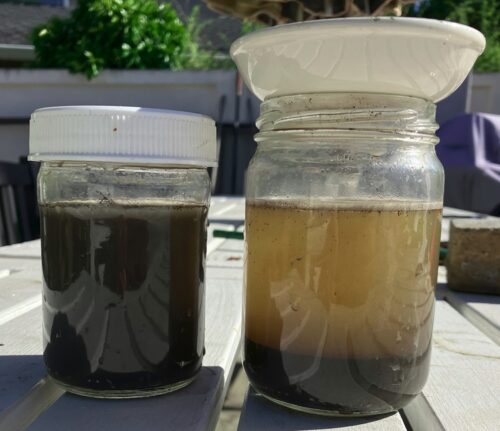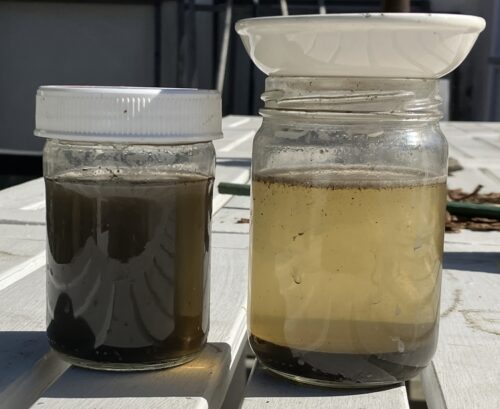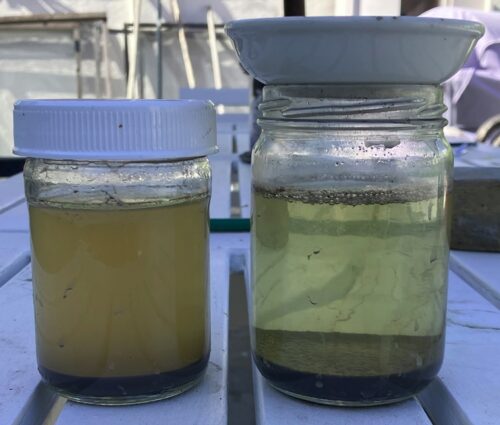Introduction
I’ve been trying to refine my backyard soil into some workable clay in order to further my metal casting project. As you can imagine, this comes with some challenges as not all clay, even when purified, is suitable for making stuff. In the case of the clay in my area, it’s very sticky and plastic, cracks when drying, and has low wet strength. Because of this, I’ve tried a few things to improve its working properties, with some success and some failure.
I started by creating a light slurry of dirt and water to separate the clay, which stays suspended in water for a while, and the sand and silt, which sink to the bottom.
Oil
For the sand-dirt molds I made for zinc casting, I used vegetable oil to make the dirt less sticky before kneading in the sand. I tried something similar with this purified clay, kneading in thread-cutting oil (what I had on hand), which successfully reduced the stickiness of the clay but resulted in very weak dried clay that fell apart under its own weight when I picked the test piece up. I suspect the oil interfered with the clay particles’ ability to hydrogen bond to each other, which holds the particles together before firing.
To confirm this theory, I made a sand-dirt brick without oil by mixing up a thick mud, adding “some” sand in it, and pouring it into one of the holes in a cinder block as an impromptu mold. As it dried, it shrank quite noticeably, by about 10 – 15%, and did so, to my surprise, without cracking. Anyhow, breaking the brick apart into chunks and comparing their strength to similarly-sized chunks of sand-dirt made with oil, the sand-dirt made without oil was indeed a bit stronger. However, I won’t jump to conclusions since this difference could just be due to a different ratio of sand and dirt, which I didn’t measure precisely.
Vinegar
According to this map (I’m in zone 145), the soil in my area is rather alkaline in addition to having high clay content. On reading a few online sources, I found out that this could be causing some of the problems.
I tried mixing liberal amounts of vinegar with the clay to reduce its pH, basically rehydrating some dry clay completely with it, which caused the release of some gas bubbles. The vinegar dramatically reduced both stickiness and plasticity, which were further reduced by the addition of diatomaceous earth (what I had on hand) as a tempering agent to prevent cracking when drying. The resulting clay, although not sticky anymore and with significantly improved wet strength, was not plastic enough to make much out of. By adding a lot of water I made it soft enough to make a pinch pot, which was able to hold itself together while wet but immediately fell apart after it dried similar to the oil-clay. The shards spalled and shattered when fired.



I also added vinegar to a jar of clay suspended in water and it dramatically reduced the settling time from about 6 hours to just minutes. Here are some pictures taken at intervals of “when I felt like it” showing the effect; the jar on the left is normal clay, the one on the right has vinegar:






My guess at what’s going on is that there are carbonates (CO32-) in the soil that are protonated by the vinegar, converting them to bicarbonate (HCO3–) ions, which stay dissolved, and carbonic acid (H2CO3), which decomposes into carbon dioxide (the gas released) and water. At the high temperatures involved in firing, the bicarbonate also decomposes into carbonate, water, and carbon dioxide, causing spalling.
Conclusion
Thinking that the oil-clay had contaminated the vinegar-clay, or that the diatomaceous earth was causing the spalling, I tried heating samples of each with a blowtorch. The oil-clay held up fine, whereas the vinegar-clays both with and without diatomaceous earth spalled.
After failing to improve the clay with both vinegar and oil, I tried simply adding diatomaceous earth and nothing else. The clay was plastic, but not too sticky, although it still tended to crack under tension and had low wet strength. After this, I also tried taking a sample of raw dirt and making something out of it. It was much less sticky than I remembered, so I think the overly-sticky clay I originally used was either too wet, or had too much organic material in it.

